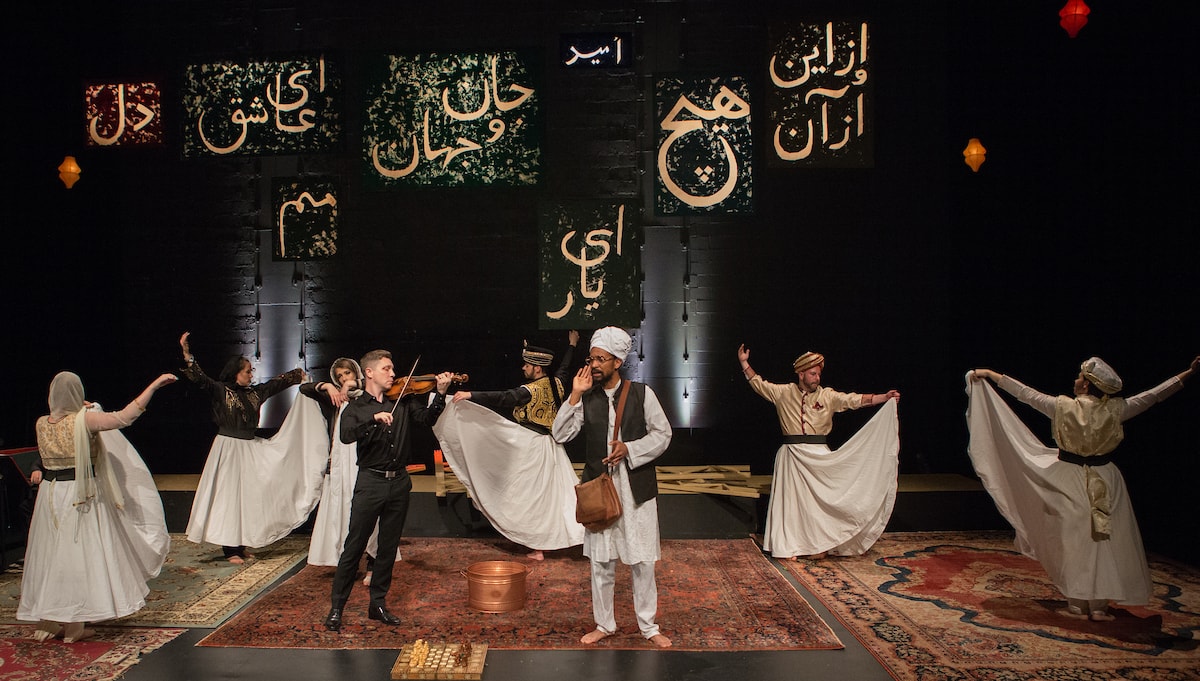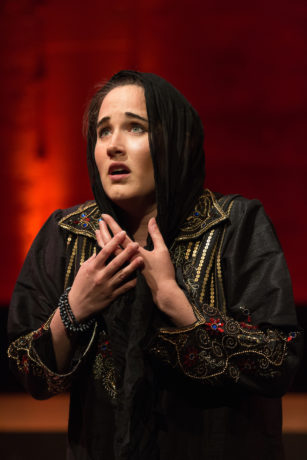The In Series is a place for thought, debate, history, and innovation. With the noble goal to invigorate contemporary theatre, to create innovations in “opera and song,” to “reimagine these forms, folding in an expanding range of aesthetic and cultural traditions,” productions include new versions of classics like The Marriage of Figaro and new works based on the broad archive of Jazz Age music. In The Tale of Serse, the audience enjoys a reimagined and pared-down version of George Frideric Handel’s 1738 opera seria, complemented by selections from the poetry of Rumi, the 13th-century Sufi mystic.

Timothy Nelson’s director’s notes reveal thoughtfulness behind the concept, profound respect for Rumi, and more reluctant affection for Handel (Nelson problematizes the Enlightenment’s attitudes toward the rest of the world extensively), forged into a leaner musical work focused on the theme of suffering. While it is set in 5th century BCE in the kingdom of Xerxes, this “Tale” is not really a Persian one any more than Handel’s was. Instead, it is a commentary on the perceptions of Handel’s time, or more specifically, naïveté and the destructive feelings of jealousy and betrayal that spring from our infantile, and all-too-human, misunderstandings.
It is in this regard that the work succeeds, delivering commentary through the words of Rumi, sung mostly by Elviro, (transformed from Handel’s servant to the role of narrator and mystical poet). Moments where the characters achieve fleeting self-awareness are underscored by such reflections as “non-existence fears it might be given human form.” The audience is cast in a Brechtian analysis of the behavior of Xerxes, his brother Arsamene, and their mutual object of affection, Romilda.
Much of the direction works to fuel this detachment and keep the intellectual study of politics and gender roles in the fore. Nearly all the characters, including the three “lovers,” are played by female artists, with Janna Critz as Xerxes, Cara Gonzalez as Arsamene, and Jaely Chamberlain as Romilda. Dawna Rae Warren and Madelyn Wanner fill the supporting roles of Atalanta (Romilda’s sister) and Amastre (the rightful wife of Xerxes). The two male performers are Jarrod Lee as Elviro and Anthony Zwerdling as Ariodate (father to Romilda/Atalanta). Nelson places actors in the audience during moments of debate and introduces other detachment effects (the chamber orchestra is onstage the entire show, the violinist is invited to join the performance, and the actors change into their skirts on stage for the Dervish).
The performers are polished artists of the opera, and their voices carry the score beautifully. Lee seems particularly suited to the role of mystic narrator, forging subtle emotional connections in his reactions to the scenes before him and application of Rumi as moment-to-moment commentary. Wanner is especially charming as the jilted betrothed, playing up Amastre’s agenda with just a touch of deviousness.
The score itself has been gutted of most of its variety; Nelson is so tightly focused on melancholy themes that what is showcased in Handel’s score sometimes becomes repetitive. The famous “Ombra mai fu” (an ode to a plane tree) opens the show and Critz thoroughly delivers in setting the tone for what becomes essentially a tragic meditation, with very few of the tragicomic levels of the original work. For much of the evening, it works. Characters spar over misunderstandings and compete for love, all while Elviro reflects on our core humanity with all its faults in the far more profound language of Rumi. At other times, the well of emotion runs dry along with the score, and spectators are left ironically snickering at a line like “The story becomes clearer as my words obscure.”
Production design is minimalist. Jonathan Dahm Robertson supplies a series of jaggedly placed structural supports upstage center, a variety of hanging placards with Persian calligraphy, and a few rugs adorning the stage floor. These, alongside the costumes by Donna Breslin which suggest a generalized Persian style rather than a specific time period in pre-national Iranian history (with limited light and dark contrasting palettes), remind the viewer that in Handel’s work is, in Nelson’s summary “no attempt at local colors or historical accuracy, rather history is […] a crucible through which the contemporary human condition is understood.” Lighting is mainly illumination and focus, but Marianne Meadows sets the right moods and highlights, and adds a perfectly timed storm effect that uses the entire system and all the practicals in near-choreographic perfection.

Certain details of realism are neglected. Chess is played without regard to the rules of the game; an actor scribbles without even the appearance of writing words. A letter has no visible writing upon it; the actors do not agree as to where the imagined writing is located (folding the letter in different ways for different readings). Whether these are intentional is uncertain, but they ultimately match the puzzling feelings in Rumi’s language.
For this reviewer, the concept seems to come together in two crucial moments. When the performers don their dervish skirts to become semazen, their whirl is as melancholic and slow-paced as the production in whole, asserting that even celebrations in honor of the divine are weighed by the burden of our deeply human flaws. When the entire cast joins in a choral finale under the theme “love used to hide in images,” the Rumi selections reflect on the need to “end this poem.” The Tale of Serse reveals that these fleeting conflicts over love deserve little empathy, as they are merely distractions from higher truths. Timothy Nelson’s adaptation is a reaction to Handel, one that rescues the work from obscurity by shining a disappointed lens on it, and by extension, on all our petty human conflicts.
Running Time: One hour and 55 minutes, with no intermission. Sung in Italian with English surtitles, poetry-narration in English.
The Tale of Serse performs June 8 at 8 PM and June 9 at 3 PM at the Lang Theatre, Atlas Performing Arts Center, 1333 H St NE, Washington, DC and June 14 at 8 PM, June 15 at 8 PM, and June 16 at 3 PM at the Baltimore Theatre Project, 45 West Preston Street, Baltimore, MD. For tickets visit the Atlas website or the Theatre Project website.




